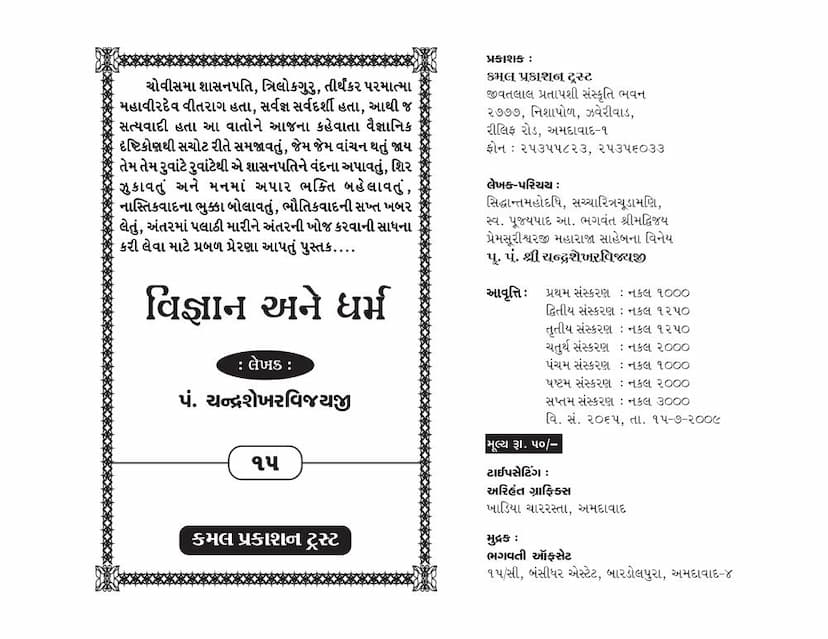Vigyana Ane Dharma
Added to library: September 2, 2025

Summary
The book "Vigyana ane Dharma" (Science and Religion) by Chandrashekharvijay, published by Kamal Prakashan, explores the intersection of scientific advancements and Jain philosophy. The author, Pandit Shri Chandrashekharvijayji, aims to demonstrate the profound wisdom of Jainism, particularly the teachings of Lord Mahavir, by aligning them with scientific discoveries.
The book argues that while science progresses, it often reveals truths that have been present in Jain scriptures for centuries. The author expresses concern about the current state of the world, which he believes is heading towards destruction due to materialism and a loss of spiritual values. He criticizes the dominance of Western thought and practices, which he feels have corrupted Indian traditions and led to a decline in morality and spiritual understanding.
Key themes and arguments presented in the book include:
- Reconciliation of Science and Jainism: The book emphasizes that Jain principles, such as the existence of the soul, rebirth, karma, and the interconnectedness of all living beings, are not contrary to science but rather are corroborated by modern scientific findings.
- Critique of Materialism and Western Influence: The author strongly criticizes the prevailing materialistic worldview and the blind imitation of Western lifestyles and ideologies, which he believes have eroded India's rich spiritual heritage and caused societal decay.
- The Nature of the Soul and Rebirth: The book delves into the Jain understanding of the soul as an eternal, distinct entity that transmigrates through various life forms based on its karma. The author cites examples from hypnotism, past-life memories, and spiritual phenomena to support the concept of rebirth.
- Jain Cosmology and Substances: The book explains the six eternal substances (dravyas) in Jainism – soul (jiva), non-soul (ajiva) comprising dharma, adharma, akasha, kala, and pudgala – and discusses their characteristics, particularly focusing on pudgala (matter) and its subtle forms like atoms and their interactions.
- The Wisdom of Jain Agamas: The author highlights numerous instances where Jain scriptures accurately predicted scientific phenomena or concepts that have only recently been discovered or accepted by modern science, such as the existence of life in elements like earth, water, fire, and air, and the detailed classification of living beings based on their senses.
- Critique of Scientific Limitations and the Need for Spiritual Insight: While acknowledging the progress of science, the book points out its limitations and incompleteness, especially in understanding the spiritual and subjective aspects of existence. It advocates for the integration of scientific knowledge with spiritual wisdom for true well-being.
- The Concept of "Syadvada" (Anekantavada): The book presents Syadvada, the Jain doctrine of manifold aspects of reality, as a sophisticated philosophical approach that allows for multiple perspectives on any given subject, thereby promoting tolerance and a holistic understanding, which the author equates with modern-day relativity.
- The Dangers of Scientific Materialism: The author expresses concern over the potential misuse of scientific discoveries, particularly in the context of nuclear weapons and their destructive capabilities, warning against the unchecked advancement of science without ethical and spiritual guidance.
- The Need for Spiritual Transformation: Ultimately, the book calls for a spiritual awakening and a return to traditional Indian values, emphasizing the importance of inner transformation over mere material progress.
The book attempts to bridge the perceived gap between science and religion by demonstrating the scientific validity of Jain teachings, encouraging readers to embrace their heritage and seek spiritual enlightenment for a meaningful life. It critiques modern society's over-reliance on materialism and advocates for a balanced approach that integrates both scientific understanding and spiritual wisdom.